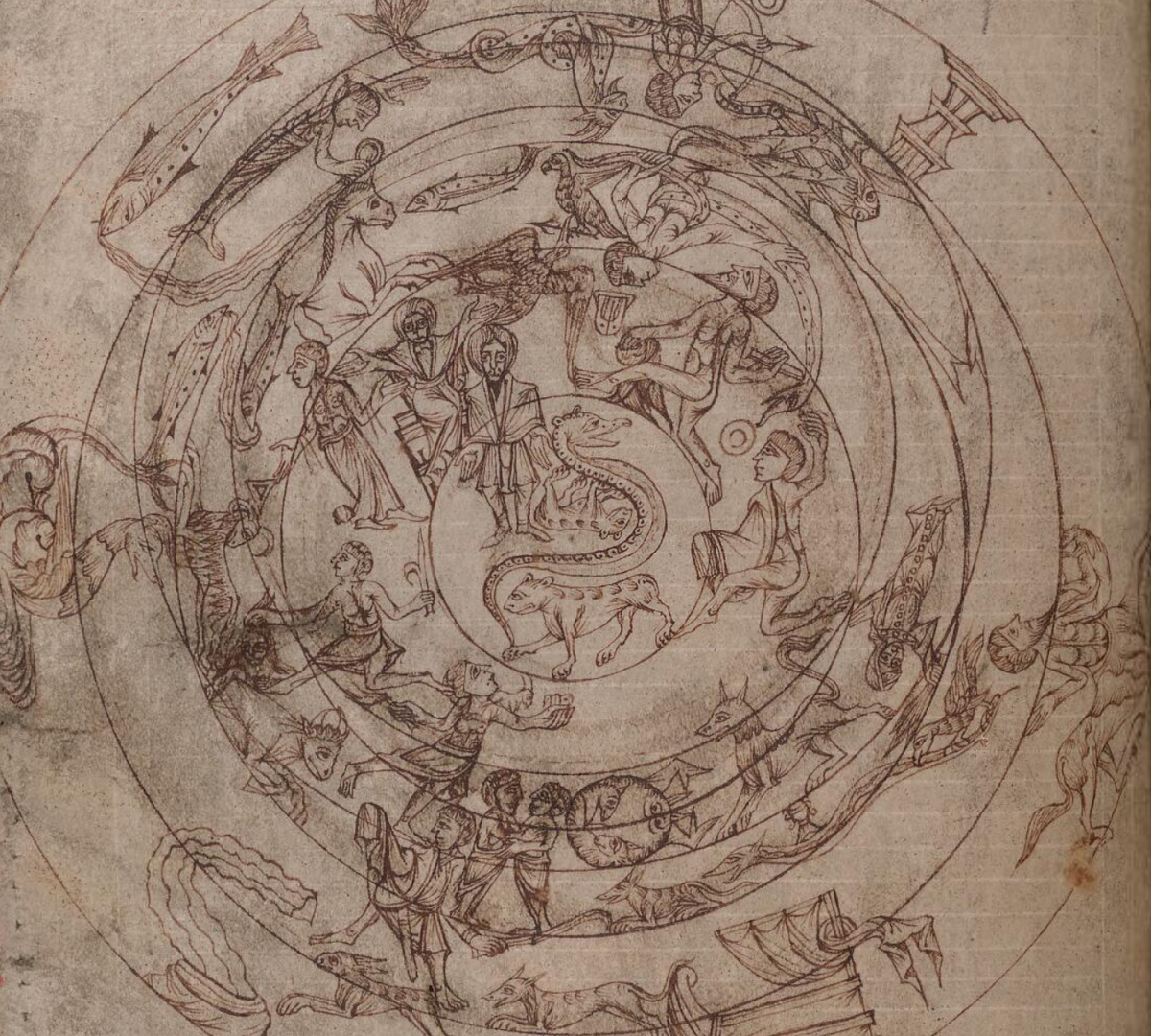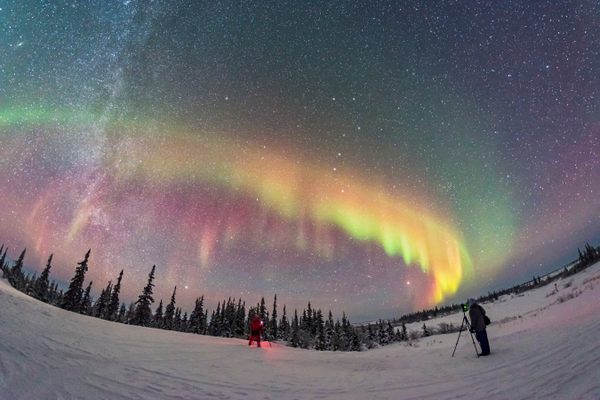Watch the Beehive Cluster and Venus Dance in the Night Sky
Summer is the time to spot a group of “sibling stars” observed for millennia. Use our gear guide to get started.
Atlas Obscura’s Wondersky columnist Rebecca Boyle is an award-winning science journalist and author of the upcoming Our Moon: How Earth’s Celestial Companion Transformed the Planet, Guided Evolution, and Made Us Who We Are (January 2024, Random House). Throughout the summer, she’ll be sharing the stories and secrets of our wondrous night sky.
Most denizens of the summer night sky are easy to find: There’s the bright stars Vega and Arcturus, the constellation Cygnus the Swan, the Big Dipper. But one of my favorites is a little harder to see, and worth the effort and the small amount of equipment you’ll need to do it. The Beehive Cluster, also known as M44, is as much a harbinger of summer as the sound of wind chimes and katydid calls.
This week, the Beehive is joined by the planet Venus, shining bright in the western sky after sunset. The pairing is a great introduction to celestial companions you might not otherwise see—and to some equipment you might want for the rest of your summer stargazing.
The Beehive Cluster is found in the constellation Cancer the Crab, in its “chest,” according to Ptolemy. It is also known as Praesepe, Latin for crib or manger. At a very dark site, you can pick it out as a slightly milky smudge, like a supremely faint Pleiades. Along with those famous seven sisters, it has been recorded and appreciated since antiquity; Praesepe is in the world’s oldest known star catalog, compiled by the Greek astronomer Hipparchus of Nicaea, who called it “the Cloudy Star” or “Little Cloud.” Galileo was the first to realize it was actually a group of stars. We now know it is one of the nearest clusters to Earth, containing hundreds of stars about 580 light-years from us.
This week, the bright planet Venus will be your wayfinder to the Beehive. Try it with binoculars: First, find Venus in the west as dusk turns to darkness. As June passes, the planet will move higher than the Beehive on the horizon. Earlier in the month, the cluster appeared to the lower left of Venus, but by June 16 it will appear to the lower right. Luminous blue-white stars will sparkle in your field of view. They formed together, from the same natal cloud of gas and dust, and are still bound by gravity into a loose cluster. They are sibling stars, traveling the void together. The photons that will pool into your eyes tonight departed these stars around the year 1443.

Venus and the Beehive will be a little too far apart to be seen together through a telescope, so a modest pair of binoculars will give a superior view. Venus alone will also look stunning with the naked eye, through binoculars, or through a telescope. It’s just a few days past its greatest eastern elongation, which is a way of describing where the planet is relative to the sun. On June 4 it was 45 degrees from the sun, as far as it gets, and it will be unmissably bright for the next few weeks. Binoculars will give you a view that shocked Galileo four centuries ago. Venus, at eastern elongation, is at first quarter, like a half-lit moon. It has phases just like the moon does, because of where it orbits relative to Earth. As the summer progresses, Venus will wane to a crescent as it moves between us and the sun, before it reaches its greatest western elongation and becomes the Morning Star this fall.
To see the phases of Venus and the Beehive Cluster, you don’t need the nicest pair of binoculars, but a set intended for astronomy will work better than the cheap ones you dig out of your closet once in a while to use at a baseball game. Look for binoculars with at least 7x magnification and at least 35 millimeter aperture; 10x magnification and 50 mm aperture is even better. Higher magnification will make things look closer, and the wider the aperture, or opening, the more light gets in to be magnified. Beyond 10x50, it can be hard to hold the binoculars steady enough, so you might want to use a tripod.
Binoculars can be the biggest-ticket item in your stargazing kit. Though they are not necessary, they are fun, and easier to use and less expensive than a telescope. Below are a few more recommendations to make summer stargazing a little more comfortable, and maybe even a little more wonderful.
The Basics: GPS Locator, Planisphere, and a Red Flashlight
First, know thy location. The stars you see are different across the year and across the hemisphere, so it’s helpful to know your latitude (your smartphone can tell you). Once you have your coordinates, you can use an app or a map to find the stars. I prefer to use a physical planisphere, which is just a circular star chart that can be adjusted for different times of year. The best ones are viewable in very low light or with a red flashlight. My go-to is The Night Sky by David Chandler Co., which comes in different editions for every 10 degrees of latitude in the northern hemisphere.

Red light will not harm your dark-adapted vision like blue or white (which is actually mostly blue) light. Red flashlights and headlamps are relatively easy to find, but in a pinch, a small piece of red tape or red Sharpie over the lens works just as well. My favorite astronomy flashlight is a Mini Maglite covered with tail-light tape, which you can find at any auto parts store.
Nice to Have: A Comfortable Chair and Binoculars
Any chair or blanket will work, of course. But if you want to splurge, I recommend this reclining camping chair by NEMO Equipment, which is rugged enough to go anywhere and comfortable enough to use on your patio (which I do).
Astronomy-specific binoculars often come with coated lenses and specialized prisms that improve viewing in darkness. Look for at least 7x magnification and 35 mm objective lenses, but higher magnification and longer lenses will let you see more. I have this pair by Celestron.
If you want to go straight to looking at planets, fainter star clusters, and distant galaxies and nebulae, you might want to invest in a telescope. The options are as varied as the stars in the sky, or almost, so I recommend starting with Sky & Telescope’s guide. But if you just want a relatively modest option, a basic reflector-style telescope will do the job. The most important feature of a telescope is its aperture, also known as its objective. A larger aperture will let you see more objects and fainter objects. Reflectors with decent aperture can be had for a few hundred dollars.
Super Splurges for Next-Level Stargazing
I am a firm believer that the night sky is something everyone should just see for themselves. This is something anyone can do, regardless of income or location, and moreover, it’s something every human who ever lived before us also did. But if “pics or it didn’t happen” appeals to you, then you might want to upgrade to an astrophotography kit. Celestron’s Inspire 100AZ refractor telescope comes with a built-in smartphone adapter, so you can take photos directly from your scope.
If you want a dedicated setup, you can take astrophotography to a much higher level with the Vaonis Vespera, which can find objects automatically and track them, compensating for Earth’s rotation. It will stack multiple images of a single object to bring out more detail, producing photos with much higher resolution than anything you would see through the telescope on your own.
If you’ve won the lottery, then you might want to check out Unistellar’s eVscope 2, which has Nikon-built lenses, proprietary software that de-noises images from light polluted areas—which is pretty much everywhere—and an app that can find anything in the night sky for you, automatically.
You can fall down an equipment rabbit hole very quickly. Or, you could just … Go out and look. Even without binoculars, Venus will be lovely to see this week. Mars will be near it all month long, and bright enough to see without any equipment at all. Your companion planets, twin worlds to this one, are right there for the seeing, just above the horizon. Go and say hello.
Each item is independently selected by our editorial staff. If you buy something through our links, Atlas Obscura may earn an affiliate commission.












Follow us on Twitter to get the latest on the world's hidden wonders.
Like us on Facebook to get the latest on the world's hidden wonders.
Follow us on Twitter Like us on Facebook